| Srl | Item |
| 1 |
ID:
160662
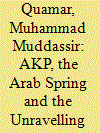

|
|
|
|
|
| Summary/Abstract |
The rise of the Adalet ve Kalkınma Partisi (AKP), its domestic and foreign policy successes and its early response to the Arab Spring made it popular in the Arab world. Many inside Turkey, the US and the Arab world saw the AKP as an Islamist party with a difference, that could be a ‘model’ for the Arab countries struggling with a democratic deficit. The violent turn taken by the uprisings in Syria, Iraq and Egypt and the internal developments in Turkey that followed afterwards, however, exposed the limitations of the ‘model.’ This essay argues that Turkey cannot be a ‘model’ as it suffers from shortcomings, but it can offer some lessons for the Arab world.
|
|
|
|
|
|
|
|
|
|
|
|
|
|
|
|
| 2 |
ID:
160660


|
|
|
|
|
| Summary/Abstract |
The successful conclusion of the Belt and Road Initiative (BRI) Summit in Beijing recently has raised a number of questions about India’s strategy to counter the Chinese project. The One Belt One Road (OBOR) initiative which China is implementing along with other partners is primarily aimed at strengthening its economy which was impacted by the global financial crisis of 2008–2009. Through this flagship scheme China will develop large-scale projects in infrastructure such as roads, railway lines, sea ports and airports. Such extensive activity will ensure Chinese influence and clout in different parts of the world. The expanding role undertaken by Beijing via OBOR especially in South Asia has made India apprehensive. China has even bypassed India’s concern and contention on the China–Pakistan Economic Corridor (CPEC) which passes through Pakistan Occupied Kashmir (POK). Hence, based on the above issues, the article examines India’s reservations, the response to the challenges posed by OBOR and the initiative’s long-term consequences.
|
|
|
|
|
|
|
|
|
|
|
|
|
|
|
|
| 3 |
ID:
160661
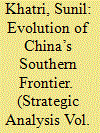

|
|
|
|
|
| Summary/Abstract |
The People’s Republic of China (PRC)’s case on the Sino–Indian boundary question has not received the sort of attention it deserves with the result very little is known about it. While India appears to have inherited its northern frontier from the British with some ambiguities, Manchu China’s territorial bequest to the Republic of China (RoC), in comparison, is more straightforward. Both foreign and Indian writers have subjected the Indian case to rigorous scrutiny. However, the PRC’s case has, thus far, escaped similar scrutiny. Consequently, the burden of proof appears to have been shared asymmetrically between the Indians and the Chinese. An attempt has been made to trace the evolution of China’s southern frontier and in so doing; the RoC/PRC’s cartographical encroachments on Indian Territory in the two sectors between 1922 and 1960 will be examined. The unilaterally declared Sino–Indian boundary alignment emanating from these cartographical encroachments finds no support in history, for nothing happened in those 38 years or before or after, to give rise to such a claim. There is neither any evidence to suggest that the cartographically encroached territories had ever been a part of China at any time in the past, nor was any proof forthcoming to show that jurisdiction had been exercised over them before October 1949, i.e. prior to the PRC’s coming into being. Chinese cartographical encroachments can be divided broadly into three phases. First, up to 1921, when neither official nor privately published Manchu/RoC maps depicted Indian Territory as Manchu/Chinese. Second, between 1922 and 1946, when some privately published maps depicted Indian territory as Chinese, but the official ones did not. Third, from 1947 onwards, the Sino–Indian boundary alignment shown in official RoC/PRC maps is the same as that in the privately published Chinese maps of the second phase.
|
|
|
|
|
|
|
|
|
|
|
|
|
|
|
|
| 4 |
ID:
160665


|
|
|
| 5 |
ID:
160664


|
|
|
|
|
| Summary/Abstract |
Wherever Indians have migrated, they have carried with them their culture, which has subsequently served to build multi-layered bridges with their country of origin. The article studies the Indian migration to the French territory of Reunion Islands located in the southwestern Indian Ocean and delves into various factors, including the historical, demographic, socio-economic aspects of the evolution of the Indian diaspora. The article attempts to present the mosaic of the Indian diaspora’s dynamic and its potential in the context of French policies and the ethno-religious issues superimposed over the current regional geopolitical environment.
|
|
|
|
|
|
|
|
|
|
|
|
|
|
|
|
| 6 |
ID:
160669
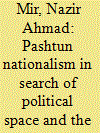

|
|
|
| 7 |
ID:
160668
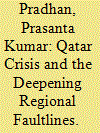

|
|
|
| 8 |
ID:
160663
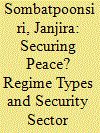

|
|
|
|
|
| Summary/Abstract |
This article examines how regime types shape security sector reforms, that are integral to the peace processes in Thailand’s Patani and the Philippines’ Mindanao. Lessons drawn from Thailand and the Philippines, illuminate the interplay between regime types and peace processes and reveal that: (1) democratic regimes tend to address aspects of security sector reform; (2) military regimes may cherry-pick a security agenda for tactical reasons, while turning peace talks into ‘ceremonial structures’; (3) weak democratic institutions are not necessarily amenable to security sector reform, but democratic spaces can empower civil society to propel security actors to embrace some degree of reform.
|
|
|
|
|
|
|
|
|
|
|
|
|
|
|
|
| 9 |
ID:
160666


|
|
|
| 10 |
ID:
160667


|
|
|